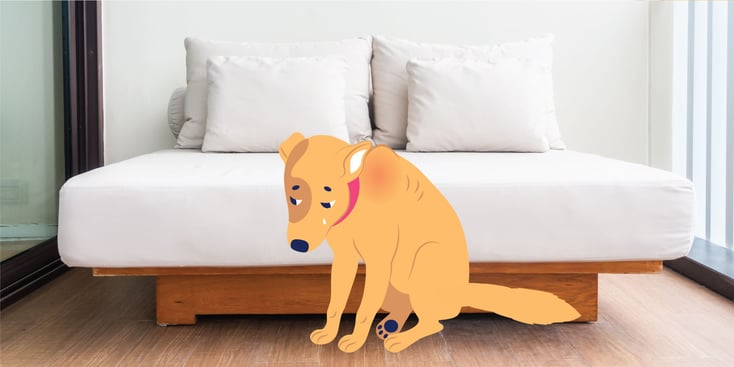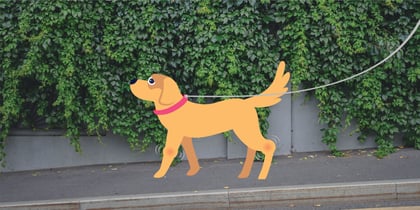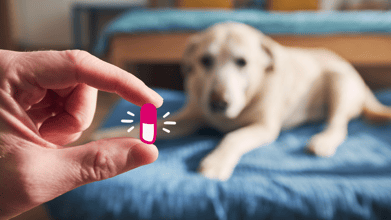What Causes Shoulder Pain in Dogs?

Table of Contents
Shoulder pain in dogs can be a troublesome thing to diagnose and treat, often because the signs come and go. All dog breeds and ages can be affected, but we see it more commonly in large or giant breed dogs under two years old. Breeds such as Labradors or Collies are more prone to shoulder problems.
The Shoulder Joint
The shoulder joint is a complex structure made up of bones, ligaments, tendons, and muscles. Two bones make up the joint. The scapula has a smooth concave end that fits perfectly with the head of the humerus bone to form a ball and socket joint. To support the joint, there are ligaments, tendons, muscles, and a joint capsule allowing the shoulder to perform a wide range of movements.
What Are the Signs of Shoulder Pain in Dogs?
It can be challenging to spot that the pain is coming from the shoulder, but clues for shoulder pain include:
- Limping or reluctance to fully weight bear
- Limping that comes and goes
- Holding the leg up or ‘pointing’
- Hopping or skipping
- A reduction in the size of the muscles, tightening, or banding appearance of the muscle over the shoulder
- Pain when touching around the shoulder, head, neck, or leg
- Biting or licking at the leg
- Swelling around the joints or shoulder region
Is Your Pet Dealing With Chronic Pain?
We’ll evaluate your pet in your home and make a plan to help them feel better soon.
How is Shoulder Pain Diagnosed in Dogs?
The first step is to book an appointment with a veterinarian. The veterinarian checks your dog from nose-to-tail, conducting a range of motion tests to try and detect which part of the leg is hurting.
Your vet may try a course of anti-inflammatory or pain relief medication initially to see if this fixes the problem. In addition, they’ll prescribe strict rest — that means preventing your dog from using the stairs, stopping any rough play, and keeping them on a leash for short, toilet-break walks only. Although this might seem harsh, it’s an essential part of their recovery so it’s critical that you help them rest. If your dog is prone to playing when you can’t supervise, you may need to use a dog crate to limit their activity when you can’t be there to monitor them.
If unsuccessful, X-rays under sedation will identify any bony abnormalities. However, an X-ray is not good for picking up soft tissue injuries, so more advanced techniques such as ultrasound, a CT, or an MRI scan may be needed. CT or MRI images allow veterinarians to specifically pinpoint the causes of shoulder pain and treat them appropriately.
What Are the Causes of Shoulder Pain in Dogs?
Soft tissue injury
This is a sudden onset injury to the muscles around the shoulder caused by trauma or overexercise. It will usually resolve within 7-10 days using anti-inflammatory medication and complete rest.
Osteochondritis (OCD)
Osteochondritis of the humerus sounds complicated. OCD is a loose flap of cartilage or a lesion that occurs at the tip of the humerus. This can be diagnosed on X-ray, CT scan, and during exploratory arthroscopic surgery.
Treatment for OCD is the removal of the flap of cartilage via an arthroscope under anesthesia and the prognosis is usually very good after the removal.
Sometimes dogs who have one OCD lesion can have other OCD lesions so it’s important that your veterinarian has fully examined both legs and take x-rays or scans of both forelimbs.
OCD lesions are common in younger dogs, usually between five months and two years old.
Medial Shoulder Instability (MSI)
Medial Shoulder Instability occurs when the ligaments and tendons deep inside the shoulder joint are injured. This causes instability of the joint, pain, and inflammation. Medical therapy is usually prescribed including complete rest, physiotherapy, and pain management medication.
Biceps Tendonitis (BT)
Biceps Tendonitis is a painful condition brought about by repetitive strain injury. This condition is more commonly seen in middle-aged to senior dogs as they have used this muscle repeatedly their whole lives.
Diagnosis can be difficult and many tests are needed including sedated examination, X-rays, ultrasound, and CT scan.
Treatment starts with long periods of complete rest and anti-inflammatory medication. If unsuccessful, surgery is done to cut the biceps tendon, solving the issue but weakening the stability of the joint. The prognosis depends on how severe the problem is; most dogs will make a fair or good recovery in three to nine months.
Bicipital Bursitis
A common cause of shoulder pain in dogs is bicipital bursitis, an inflammation of the bursa sacs located in the shoulder joint. This condition is typically caused by repetitive movements, overexertion, or aging, and can be diagnosed through physical examination, x-rays, and ultrasound.
Supraspinatus Tendinopathy
The supraspinatus muscle runs along the front of the scapula bone and can be damaged at the attachment site to the humerus bone. Supraspinatus tendinopathy is most often seen in athletic or working dogs. In a recent evaluation of the literature, it was common for other issues such as mineralization of the tendon or osteoarthritis to be present, making recovery times longer.
Many diagnostic tests such as ultrasound, X-rays, MRI, or CT are needed to determine the full extent of the damage to the shoulder joint due to supraspinatus tendinopathy.
Fracture
Very rarely and often after severe trauma like a road traffic accident, dogs can fracture their scapula or humerus. Fractures are very painful and your dog will often be vocalizing in pain, refusing to move or put weight on the leg, and appearing very distressed.
Should My Pet Be Seen by a Veterinarian?
1. Have you noticed changes in your pet’s appetite?
2. Does your pet have diarrhea or loose stools?
3. Have you noticed changes in your pet’s thirst/water consumption?
4. Is your pet having accidents in the house?
5. Is your pet pacing and unable to settle?
6. Is your pet panting more than usual?
7. Is your pet whining or vocalizing more than usual?
8. Is your pet shaking more than usual?
9. Is your pet hiding or avoiding physical contact more than usual?
10. Is your pet more lethargic and sleeping more than usual?
11. Are you concerned about changes in your pet’s behavior?
12. Is your pet scratching their ears?
13. Is your pet licking their paws more than usual?
14. Does your pet have a rash?
15. Is your pet moving more slowly than usual or having a harder time getting up or down?
View Results
Should My Pet Be Seen by a Veterinarian?
1. Have you noticed changes in your pet’s appetite?
2. Does your pet have diarrhea or loose stools?
3. Have you noticed changes in your pet’s thirst/water consumption?
4. Is your pet having accidents in the house?
5. Is your pet pacing and unable to settle?
6. Is your pet panting more than usual?
7. Is your pet whining or vocalizing more than usual?
8. Is your pet shaking more than usual?
9. Is your pet hiding or avoiding physical contact more than usual?
10. Is your pet more lethargic and sleeping more than usual?
11. Are you concerned about changes in your pet’s behavior?
12. Is your pet scratching their ears?
13. Is your pet licking their paws more than usual?
14. Does your pet have a rash?
15. Is your pet moving more slowly than usual or having a harder time getting up or down?
Share Quiz
How to Treat a Dog Shoulder Injury
Treating a dog's shoulder injury involves a blend of rest, medication, and therapy. Here's how you can help your pup get back on their paws:
Pain Management Medication
Medication prescribed by your vet can be effective in reducing your dog's pain, such as anti-inflammatories & pain killer.
Rest
Rest is crucial for your dog's recovery. It is important to limit their activity and allow their shoulder to heal.
Physiotherapy
Physical therapy can improve your dog's mobility and range of motion. Your vet may recommend exercises or stretches to help your dog recover.
Hydrotherapy
Hydrotherapy can be a useful form of physical therapy for dogs with shoulder pain. It involves using water to exercise and rehabilitate your dog's shoulder.
Laser Therapy
Laser therapy uses light to reduce inflammation and promote healing.
Massage
Massage can help ease muscle tension and promote relaxation. It can be a useful complementary therapy for dogs with shoulder pain.
Surgery
Surgery may sometimes be necessary to repair the underlying issue causing your dog's shoulder pain. Your vet can advise you on whether surgery is the best option for your dog.
Conclusion
Shoulder pain in dogs can stem from various causes, and while treatments can offer relief, pinpointing the root cause is crucial. If your dog shows signs of shoulder discomfort, it's essential to act promptly. Schedule a pain management consultation with a veterinarian to ensure your dog's optimal health and comfort. Your furry friend's well-being is worth it.
Frequently Asked Questions
Is there anything I can do at home?
At-home treatment for shoulder pain is limited. As soon as you notice any signs, rest your dog as much as possible.
If they are licking or chewing at their legs, use an Elizabethan collar (e-collar) to prevent this.
We do not recommend giving any human pain relief such as Tylenol as this can be toxic in certain doses, and can mask the severity of the pain your dog is feeling.
If joint supplements are prescribed, always use a supplement specifically formulated for dogs, and don’t forget to give the loading dose first.
Keeping your dog at the correct body weight is recommended. Measure out their food daily and go easy on the snacks!
What is the recovery period for a shoulder injury?
The recovery period for a shoulder injury typically varies from six weeks to six months. However, if repeat surgeries are necessary or both shoulders are affected, the healing time could be longer. Detecting shoulder pain early can lead to quicker treatment and shorter recovery.






